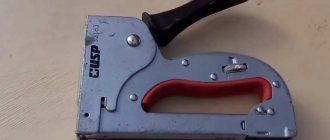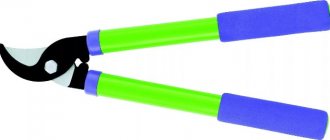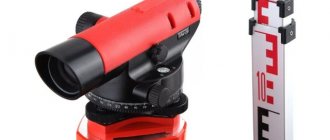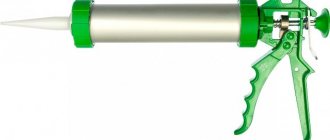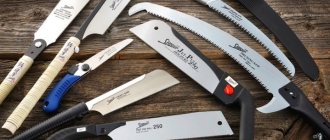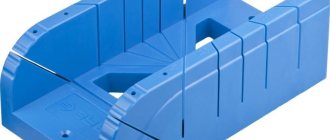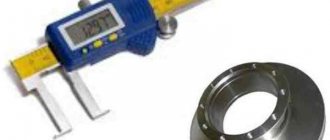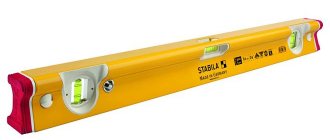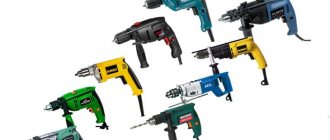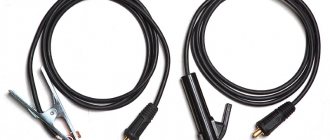Purpose and principle of operation
The advantages of the stapler lie in its safety for the operator, time savings, versatility and the ability to work in hard-to-reach places.
The need to fasten any parts arises in everyday life, not to mention construction work, so a construction stapler is used in many situations, for example:
- When installing heated floors, in particular for fastening pipes using special anchor clamps.
- When installing trim on doors.
- For attaching cardboard, film, and similar materials to plastic, wood, plywood, chipboard.
- When installing insulation.
- In furniture production, in particular when covering products with fabrics.
A construction stapler is convenient for fastening draperies, linens, posters and canvases.
Also, this tool is often used to fix electrical and television cables.
A staple gun is loaded with staples, the advantage of which over nails is the increased pressing area of the object being fastened.
The operating principle is based on pushing out the fastening element by the force of a compressed (cocked) spring.
When the trigger mechanism is activated, the spring expands and pushes the firing pin, which, hitting the bracket, drives it into the base.
No. 1. Operating principle and advantages
The first staplers date back to the 18th century. They appeared in France, at first the design was intended for fastening sheets of paper, then a mechanism for connecting thin, but already brass sheets was patented. Years have passed, new solutions have appeared, and today we are fortunate to use a tool that allows us to perform many operations. When the first construction staplers were in the hands of domestic craftsmen, they used them to fasten literally everything, even drywall to a wooden frame and cork wallpaper to the wall.
The construction stapler has many names, both professional and popular: tacker, nailer, stapler, stapler, stapler. Surely, there are some other names, and all of them in one way or another hint to us about the principle of operation of this tool.
The design of a construction stapler is simple. The main element is a spring, coiled or flat spring. The spring first compresses and then expands, giving force to the staple and driving it into the material. How is the spring compressed? Thanks to muscular force in mechanical staplers, or thanks to the motor - in electric ones. There are also pneumatic staplers, they work somewhat differently, but in everyday life and even when performing repair work, such models are rarely used.
The stapler can work not only with staples, but also with nails, pins and some other fasteners. Some models, like their stationery counterparts, can bend the paperclip tabs from the reverse side.
We advise you to study - Types of hammers and their purpose
The main advantages of a construction stapler include:
the fastening process takes less time and effort compared to using a hammer, and you won’t be able to hit your fingers; one hand always remains free, and when performing work, for example, on a stepladder, this is very important; the ability to mount in hard-to-reach places; precise transfer of impact energy, so you can work with very complex surfaces without fear of damaging them; durability and reliability of the tool, because there are a minimum of parts in it - there is nothing special to break; multifunctionality.
Note that not every fastener can be hammered using a tacker, although the tool has long gone beyond just a staple driver. Each type of stapler (mechanical, electric and pneumatic) has its own disadvantages, which we will discuss below.
Device and characteristics
The mechanical version has the simplest design, consisting of elements such as:
- The body is the basis of the instrument. All mechanisms and parts are located inside and outside it. The body has a handle for holding with one hand.
- Cocking handle - simultaneously cocks the striking mechanism through the cocking mechanism and the cocking spring, and is also a kind of trigger, when pressed, the fastener is fired.
- Transport lock - placed on the cocking handle, which prevents cocking of the striking mechanism.
- Impact mechanism - includes a spring, hammer, shock absorber and firing pin. The latter, when the impact mechanism is triggered, acts directly on the fastener, driving it into the material. Also part of the mechanism is a screw for adjusting the force of the mainspring.
- The magazine for fasteners is located in the lower part of the housing. A fastener is inserted into it, which is fed under the firing pin through a rammer mechanism consisting of a rammer, a spring and a latch.
- Tip - located in the front part of the tool, has an outlet hole for fasteners, allows you to drive staples into the intended point.
NOTE:
In electric staplers, an electric motor is responsible for charging the spring, while pneumatic versions are powered by compressed air; such models have a second name - a staple gun.
Material
Mechanical construction staplers are made of metal (usually cast aluminum, steel) and impact-resistant plastic such as ABS.
The latter are much lighter and not subject to corrosion, but the metal is more suitable for daily use and is resistant to mechanical damage, which is difficult to avoid, for example, during construction.
The handle and cocking handle are rubberized.
Dimensions and weight
The length of mechanical models is 155 - 230 mm, height 120 - 200 mm, and width 28 - 35 mm, depending on the size of the staples the tool is designed to work with.
Such models weigh 300 – 800 g.
As for electric staplers, their length is in the range of 220 - 240 mm, height 160 - 228 mm, width 60 - 100 mm, and weight 0.6 - 2 kg.
Operating mode
One of the main characteristics of a construction stapler is its impact force.
This indicator depends on the shock spring (on the operating pressure of the pneumatic tool) and is adjusted with a special adjusting screw, which allows you to select its value for working with staples of the required size (indicated in the instructions).
NOTE:
The impact force of mechanical models is noticeably lower than that of electric and, especially, pneumatic construction staplers.
Electric and pneumatic tools also have such a characteristic as impact frequency - the number of staples driven per minute.
On average, the rate of fire of electric staplers is 20 – 30 shots, sometimes up to 50.
For pneumatic construction staplers, the normal output is 50 – 60 shots.
The depth of driving staples depends not only on the force of impact of the stapler, but also on the characteristics of the material into which the fasteners are to be driven.
In fact, it is equal to the length of the legs of the staple.
For mechanical models this is usually 10 - 15 mm, for electric ones 20 - 25 mm.
The pneumatic tool remains the record holder here, capable of driving 50-80 mm staples, and some even 100 mm nails.
A unique characteristic of pneumatic staplers is the operating pressure, which largely affects the dimensions of the fasteners being driven.
The minimum is 4 Bar, and the average is 5-6 Bar.
A compressor with the appropriate characteristics is selected for these parameters.
Additional functions
Some useful features of construction staplers that make operation easier and increase work efficiency:
- Push + Release system - allows you to control the moment of impact and prevents arbitrary activation of the trigger mechanism. Until the tip of the tool is pressed to the surface, it is impossible to fire a shot.
- The DuoTac system is a feature that allows you to hammer two thin staples at the same time.
- The number of staples indicator is either a control window or transparent walls of the magazine, in which you can see how many staples are used in it.
- Adjusting the impact force is more of a mandatory function than an additional one, however, it is not present in all instruments. Usually it is an adjusting screw, however, some electric staplers are equipped with electronic adjustment, which allows you to accurately set the impact force for a specific material.
- A safety device against accidental shooting - blocking the release key with a separate button (for electric models) or with a metal bracket.
Among other things, professional staplers can be equipped with multiple and/or re-strike functions, which increases productivity when installing a large number of fasteners.
How to use a stapler
Refueling
In order to load the stapler with staples (i.e. load the staple gun), you must first move away the spring intended for pressing them.
The staples themselves are placed in a special groove, in which, in fact, they need to be placed. After this, the spring is put in place. The tool is completely ready for use. Video: how to thread a stapler with staples
Now you know how to insert staples into a stapler, we can proceed directly to work.
Shot
In order to fix the necessary element, you should firmly attach the device to the place where you plan to hammer the bracket. After this, without lifting the device from the surface, you must press the trigger button (lever). If these manipulations are successful, you will hear a characteristic sound and see a staple inserted into the material.
Tips and tricks
In order to protect yourself when working with a construction stapler, you should follow some rules:
- If you use a mechanical model of the device, it is necessary to adjust the screw regulator. This operation should be performed on a piece of rough material by rotating the screw from minimum to maximum. If the staple goes in all the way from the first shot, you can start working on the “finishing” part. Otherwise, re-adjustment is required;
- In order to drive the staples at the same distance, you should first mark the necessary places with a pencil or ballpoint pen;
- Hold the material with your free hand so that when firing it does not move from the pre-designated place;
- Keep track of the number of staples in the “store” so as not to be left without a single fastening element at the most inopportune moment;
- After finishing work, secure the handle with the safety catch to prevent spontaneous or accidental firing.
In addition to all the above tips, you may also need help repairing this construction tool, since the stapler, like any other equipment, tends to break.
Repair
The most common cause of stapler failure is a breakdown of the impact mechanism. However, in order to get to it, you must first disassemble the tool. This can be done by performing a number of simple operations:
- Remove the adjusting screw;
- Remove the spring;
- Remove the protection cover;
- Remove the pins;
- Remove the lock washers.
If the list of actions does not make it clear to you how to disassemble the stapler, then you can see this in the video below.
After performing all the above manipulations, you will be able to see the drummer, which, for the most part, fails due to the exhaustion of its resource.
In order to repair this element, you should remove it, place it in a vice and, using an ordinary file, give the striker its original shape.
That's it, the repair is completed, and the instrument is again in full combat readiness.
Tips on why the stapler does not work and how to fix it:
- If your tool does not finish (does not finish) the staples, then try tightening the spring, it may have weakened;
- If a construction stapler bends the staples, try adjusting the spring tension bolt (relax or tighten, experiment). Another probable cause of malfunction is a mismatch between the type of staples and the structure of the material - for chipboard and plywood it is recommended to buy staples made of hardened steel;
- If the staples do not come out of the stapler, but bend and get stuck inside, perhaps the striker (tongue) that pushes them has become rounded and needs to be sharpened;
- If the mechanism itself works, but the staple does not fire, it is possible that the staple does not grip, or the firing pin has worn out. Try filing the firing pin and turning the damper with the other side.
Watch the video to see how to repair a staple gun with your own hands.
Video: do-it-yourself stapler repair
How to disassemble a furniture stapler, what to do if it jams. What could be the reason, what to do if the construction stapler does not fire staples:
The real-time video shows step by step how to disassemble the stapler, what could be the cause of the breakdown and how to fix it yourself, as well as how to assemble the stapler.
Types of construction staplers and their prices
The staple gun is divided into:
Mechanical (manual) stapler
It operates by hand, has a compact size and light weight, has a small magazine capacity and low productivity.
In addition, with such models it is quite problematic to fasten materials to a solid base.
Mechanical construction staplers can be conventional (with a coil spring) or spring (with a leaf spring).
The first is the simplest, cheap, with an adjusting screw located in the upper part of the body, on the opposite side of the tip.
Price 350 – 800 rubles.
Leaf spring tools are more expensive, but have less recoil, are more powerful, last longer, and are easier to cock.
The cost can reach 2.5 thousand rubles and more.
Electric stapler
A more productive option, where the electric motor is responsible for cocking the spring acting on the firing pin.
The electric stapler, depending on the energy source, can be mains-powered (powered from a household electrical outlet) or rechargeable (with a removable battery).
All of them are larger and more massive compared to the previous version, and in the former the operating radius is limited by the long cable, so you often have to use extension cords, while the latter are inconvenient due to the bulky handle to which the battery is attached, as well as the overall massiveness.
The average price is from 1200 to 6000 rubles, and good battery options will cost 15 – 25 thousand rubles.
Pneumatic stapler
Powered by compressed air supplied from a compressor.
There are no springs, and the fasteners are inserted into the material under the influence of gas pressure.
The performance of pneumatic staplers is much higher; they also have greater reliability, magazine capacity and impressive impact force.
On the other hand, all the problems in operating such a construction stapler are generated by the compressor: noise, bulkiness, and most importantly, the limited length of the hose.
The price of a gun without a compressor is 2 – 3 thousand rubles.
Like almost any tool, a construction stapler is divided into the following classes:
Domestic
It has a small working life, is made of low-grade materials, has extremely limited functionality, and is not designed for intensive, frequent use.
Professional
A high-quality tool designed for long-term intensive use, it has advanced functionality that increases ease of use and productivity.
Industrial
It is mainly used by craftsmen in production areas where high productivity and fault tolerance are required, and mobility is not of particular importance.
A good example is a pneumatic stapler, which is comfortable to work in one place.
It should be noted that mechanical staplers are divided into several types:
Classic stapler
Works with staples no longer than 16 mm.
For example, he is able to attach upholstery to the wooden frame of a sofa, a mosquito net to a window vent.
Cable
Designed for fixing cables (including electrical) on various surfaces using special brackets, the length of which depends on the thickness of the wiring being laid.
Their cost is about 5-6 thousand rubles.
Universal
Capable of working with both conventional U-shaped staples and T-shaped and nail-type fasteners (nails, pins, studs).
On the packaging of such models and on their body, as a rule, they write: “3 in 1” and even “4 in 1”, with corresponding pictures.
Hammer
It is a long handle, at the end of which there is the mechanism itself, which is triggered by the inertia of the blow.
This type of stapler-hammer is used where accuracy is not important, for example, when fixing flooring or insulation.
There are also special construction staplers designed for specific jobs, for example:
Furniture
This is usually the name for any construction stapler, however, there are models created specifically for installing wooden frames and furniture upholstery.
Upholstery
Only for installing upholstery material on various substrates.
They come in two types, some options pierce the material and bend the staples (effective for joining fabric materials, bending the edges of canvases), while others pierce the upholstery and wooden base, and with the fasteners recessed.
For fastening the lining to the sheathing
Uses special staples driven at an angle.
Roofing stapler
For fixing soft roofing materials, insulation, insulation.
Can be equipped with a retractable blade.
Types of staplers
The first step is to decide what type of staple gun you want. According to the type of driving force, construction staplers are:
- Mechanical. They are operated by hand force, have low productivity, and a small number of staples that can be “tucked” into it. With such equipment it is quite difficult to work with hard materials - you have to make a significant effort. But mechanical staplers are small in size and weigh little, which allows you to work in awkward positions. Their low price is also attractive, although there are models with a rather high price tag.
- Electrical. The staple flies out when the trigger is pulled, but the trigger mechanism is powered by electricity. There are models that run on mains power, and others that run on batteries. Naturally, productivity is higher than that of manual staplers, but prices are significantly higher, especially for cordless staplers. Also larger in size. Moreover, for models powered by mains power, the cord interferes and limits movement, while for battery-powered models, the weight and bulky handle cause inconvenience - the battery is usually attached to it from below. But the physical effort is minimal.
There are a lot of construction staplers. There are only three “drives” - they can work using the power of hands, electricity and compressed air - Pneumatic. The driving force is compressed air, under the influence of which the fasteners or nails fly out of the magazine. They also have high productivity and a large magazine that can hold a large number of staples or nails. But the hose from the compressor (and the noise from it) interferes even more than with electric models. Moving with such a unit is problematic. So this type of stapler is more suitable for professional use in a specific place.
If you need a construction stapler for one-time work - only during the construction or finishing of a house or apartment, choose a mechanical or electric one. Mechanical works in any conditions, electric only in places where there is electricity. Even battery-powered models require periodic charging. Yes, you can buy a second set of batteries for them and while one is working, the second is charging. But charging also requires electricity.
Pneumatic staplers are purchased mainly in workshops for professional use. For one-time work this equipment is too expensive and very noisy.
Construction stapler and nailer: what is the difference?
A nailer and a construction stapler (we are talking about automated models: electric and pneumatic) are very similar installation tools, but there are some differences.
Nailer (nail gun) is a nailing tool capable of driving nails of different sizes, studs and pins at high speed; some models can also work with staples.
A construction stapler works primarily only with staples; universal options are adapted to the use of nails and pins of small sizes.
The main difference between these tools is that the stapler is not suitable for work that requires high impact force and frequency of shots, i.e. in power and type of consumables.
What you need to know about construction staplers?
A construction stapler is a dangerous tool, when using it it is important to follow a number of rules:
- In some cases, it is advisable to secure the material being fastened well with a vice or clamp, this will allow you to use both hands.
- Do not point the tool towards people or animals.
- To avoid injury and damage to the tool, you must use only consumables that are suitable for the specific model.
- When working, be sure to use safety glasses with side glasses.
- Before recharging electric staplers, you must turn off the power.
- It is forbidden to use a construction stapler to work with stone, concrete and similar materials, as this can not only lead to breakage of the tool, but also injure both the master himself and those nearby.
Attention!
Great care must be taken when working with hardwood subfloors. In such cases, it is advisable to use professional equipment of suitable power.
